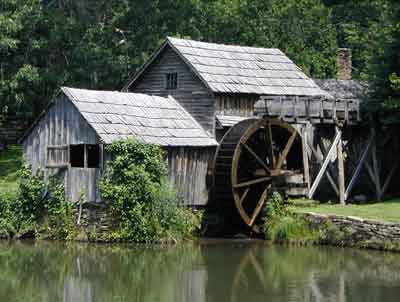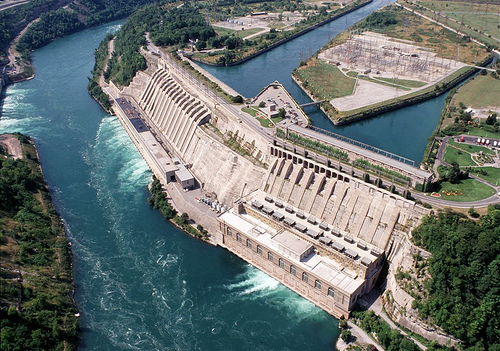One of the oldest and readily available forms of alternative energy exists on 71% of the Earth’s surface. Water, a vital part of all life, is used as power around the world. For rivers, dams can control the flow of water and harness it’s natural flow to turn generators. Perhaps the most common dam that Americans think of is the Hoover Dam, which is a dam on the Colorado River that generates up to 10.348 Terawatt-hours of electricity each year. The amount of electricity produced by the Hoover Dam is enough to sustain over 1.3 million homes in Colorado, Nevada, and California.
Hoover Dam.
Hydropower is one of the oldest forms of energy that has been utilized for over 2,000. The earliest way hydropower was used was with water wheels (pictured below). These water wheels would be attached to farms because the wheel would turn a series of gears that would grind grain, saw wood, etc. After setting up a water wheel, it required little or no maintenance. Harnessing hydropower allowed farmers to do multiple tasks at a time because water wheels were self-automated.
An old-style water wheel.
Over the years, more efficient ways of harnessing hydropower were created, such as dams like the Hoover Dam. These dams have a lot of advantages. First, they increase the water level of a river which in turn increases the energy potential. Along with this, dam operators can control water flow to suit whatever situation. If the dam is getting too blocked up, flood-gates can be opened wider to increase water flow. In addition, having a large amount of water available means that energy can still be captured even during times of drought. One of the interesting advantages of hydroelectric dams is that if electricity does not need to be created, then electricity produced by water flow can be used to pump that water back into the reservoir. This creates a situation where nothing is wasted.
Although dams are a great way to harness cheap and clean hydropower, they do have downsides. When a dam is installed, the reservoir created floods land upstream, killing plants and driving animals out of their habitats. Also, the dam itself creates a barrier for migrating fish. Fish that have traveled upstream for centuries are forced to remain where they are because of the dam, changing their entire way of life. Finally, dams interrupt the normal development of floodplains downstream. Installing dams to control water flow is a great idea in theory, but it completely changes the environment it is placed in.
A dam in Ontario.
Harnessing hydropower is a great form of alternative energy. It’s cheap, clean, and readily available. Unfortunately, modern-day dams have a ton of environmental impacts that other alternative energy-capturing methods don’t. Wind farms and solar panels produce energy just like hydropower, except they have little or no environmental impact. Environmental impacts aside, hydroelectric dams do produce a lot of electricity. In fact, the United States alone has over 80,000 dams. Altogether, hydropower makes up 7.1% of the United States total energy usage. While this doesn’t seem like a lot, other renewable energies only make up 2.4%. Hydropower is clearly a successful renewable energy source, even if it does have some environmental impacts. However, the question remains: Are these environmental impacts too much?
Sources:
http://www.alternativeenergyprimer.com/Hydropower.html
http://en.wikipedia.org/wiki/Hoover_Dam
http://ga.water.usgs.gov/edu/wuhy.html
http://www1.eere.energy.gov/water/hydro_plant_types.html
http://environment.nationalgeographic.com/environment/global-warming/hydropower-profile/




I think the intital dam construction is pretty bad because many animal’s habitats and ways of life are disrupted, especially the fish, but once that is all over hydroelectric seems pretty good to me. the land ecosystems will eventually go back to normal and the fish will adapt, hopefully. If you think about it, since the dams control flooding, they can actually help the animals environments surrounding it. floods can be devastating to habitats too. plus, no energy is wasted with hydroelectric power.
I also feel like the benefits of hydropower outweigh the problems that they cause. It’s not like generating the energy is constantly producing greenhouse gasses that pollute the area. Sure, the dam destroys a habitat, but given how much power it can produced in the right place (it’s not like they build them everywhere) I think it’s worth it.
An important point you mentioned was that of flood planes. I know in Egypt there were plans to make a dam, however it would have great destroyed the farm lands. I don’t know if they picked a new location, built it as was, or didn’t build it at all. But in areas where food is not as readily available, changing the flow of water is definitely an issue.
Newer forms of hydroelectric power exist. Tidal dams use the incoming and outgoing tides to create power, with less of a disturbance of natural habitats. Underwater turbines, depending on depth, location, and how densely they are packed together can also provide energy without too much disturbance. I think in the future, new forms of hydropower will exist
Hydropower is such a great idea because it used the resources that are abundant, without destroying them just reusing them. It has evolved over time from the water wheel to dams like the Hoover Dam that operate now. The fact that dams disrupt the animals and life living in rivers is a problem, though. If hydropower wasn’t so effective and didn’t provide as much energy as it can, then I would say it’d be too harmful; however, I think the benefits are greater and with more research and development maybe these negatives can be decreased.